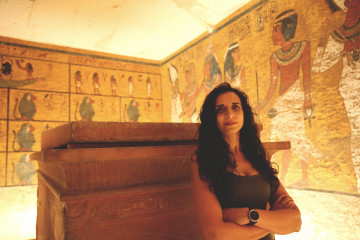

Paleoanthropologist, Neanderthal specialist, presenter, explorer and stand-up comic are just some of the hats that multi-talented Ella Al-Shamahi wears.
Think of her as the British-Yemeni Indiana Jones, digging deep (figuratively and literally) to find answers to ancient mysteries and understand, in her own words, “extinct human beings”.
"Ella unearths the truly deadly secret lurking in these tombs"
For her latest Channel 4 project, Tutankhamun: Secrets of the Tomb, Ella delves into the curse of the Egyptian pharaoh's tomb, looking into the extraordinary scientific truth behind the legend as well as the press sensation that surrounded it for decades.
“The 100-year anniversary of Tutankhamun’s tomb discovery was coming up,” Ella explains. “A film company approached me and asked if I wanted to make a documentary which would look at the curse from a scientific perspective – and of course, I said yes!”
|
The Pharaoh's Curse
Tutankhamun is thought to have become a pharaoh at the age of nine and to have died about 10 years later.
The son of religious revolutionary pharaoh Akhenaten restored the old gods and traditions, and moved the capital city of his empire back to Waset (today’s Luxor), from Akhetaten during his father’s reign.
His rule would have probably passed without notice were it not for the 1922 discovery by Britain's Howard Carter of his nearly intact tomb.
But when people who entered the tomb began dying, tales spread of a 'Pharaoh's Curse'.
In the documentary, Ella seeks to unearth the truly deadly secrets lurking in these tombs, as she travels from Tut's tomb in Egypt's Valley of the Kings, to a shrine in Wawel cathedral in Krakow, Poland.
The investigation links a series of mysterious deaths in both locations, each attributed to the 'curse'.
"When people who entered the tomb began dying and tales spread of a 'Pharaoh's Curse'"
Through filming for the documentary Ella recalls how she was able to look at the curse from a scientific perspective and ask insightful questions.
“There was a lot of hysteria at the time,” she tells The New Arab. “The press went wild, but no one was asking obvious questions, like why no Egyptian workers had died from the curse.”
To answer these questions Ella travelled to Krakow, Poland to speak with Professor Barabasz, who was also involved in a tomb opening, several decades ago.
"The press went wild, but no one was asking obvious questions, like why no Egyptians had died from the curse”
She also looked into medical science for answers.
“We found that the victims may have died of an infection,” says Ella. “The fungus aspergillus flavus was probably growing in the tomb, that could have attributed to the deaths.”
|
Battles over ownership
Carter's lavish find revived interest in ancient Egypt but also set the stage for subsequent battles over ownership of cultural masterpieces unearthed in colonial times.
International conventions and the British government's own guidance now restrict the sale of works that were known to have been stolen or illegally dug up. The British Museum has been wrangling for decades with Greece over its remarkable room full of marble Parthenon friezes and sculptures.
Egypt's own campaign to recover lost art gained momentum after numerous works went missing during the looting that accompanied former president Hosni Mubarak's fall from power in 2011.
Cairo has managed to regain hundreds of looted and stolen artefacts by working with both auction houses and international cultural groups. But Egypt has been unable to substantiate its case with firm proof that the Tutankhamun bust was illegally obtained.
A multifaceted career
Ella’s career evolution has been anything but typical. She began specialising in genetics before discovering a passion for human evolution and pivoting to a career as a Paleoanthropologist and ‘Neanderthal specialist’.
It was around this time that she was scouted by National Geographic who asked her to be one of their Explorers.
Recently Ella’s work turned more towards presenting and television.
“I gave directing a go but found I wasn’t very good at it,” she recalls. “So, I thought I’d try working on the other side of the camera.”
“There are times when you think that you’re moments away from finding a priceless artefact only to find that it’s not”
Since then, Ella has gone on to present for the BBC’s Neanderthals: Meet Your Ancestors and Horizon. Her latest documentary, What Killed the Whale, aired on Channel 4 and is still available to view here.
But it’s not all adventure and thrills, as Ella explains. “There are highs and lows when filming a documentary,” she says, “especially when you’re filming archaeologic discoveries.
“There are times when you think that you’re moments away from finding a priceless artefact only to find that it’s not.”
To help counteract the “dark stuff” in her day job, Ella turned to stand-up comedy, which she explains allowed her to have a break from fossil hunting in hostile territories and “just laugh”.
Although not your typical side gig for an archaeological explorer, Ella admits that she finds it more intellectually challenging than digging for bones and relics.
“There’s something about the human brain and understanding what makes us laugh that I find so satisfying.”
TUTANKHAMUN: SECRETS OF THE TOMB airs Sunday 19 June, 8:00 pm on Channel 4. This two-part series will be available to stream or download for free on All 4 following the transmission of Episode 1.
Sami Rahman is a freelance lifestyle writer based in London.
Follow her on Twitter: @bysamirahman




 Follow the Middle East's top stories in English at The New Arab on Google News
Follow the Middle East's top stories in English at The New Arab on Google News


